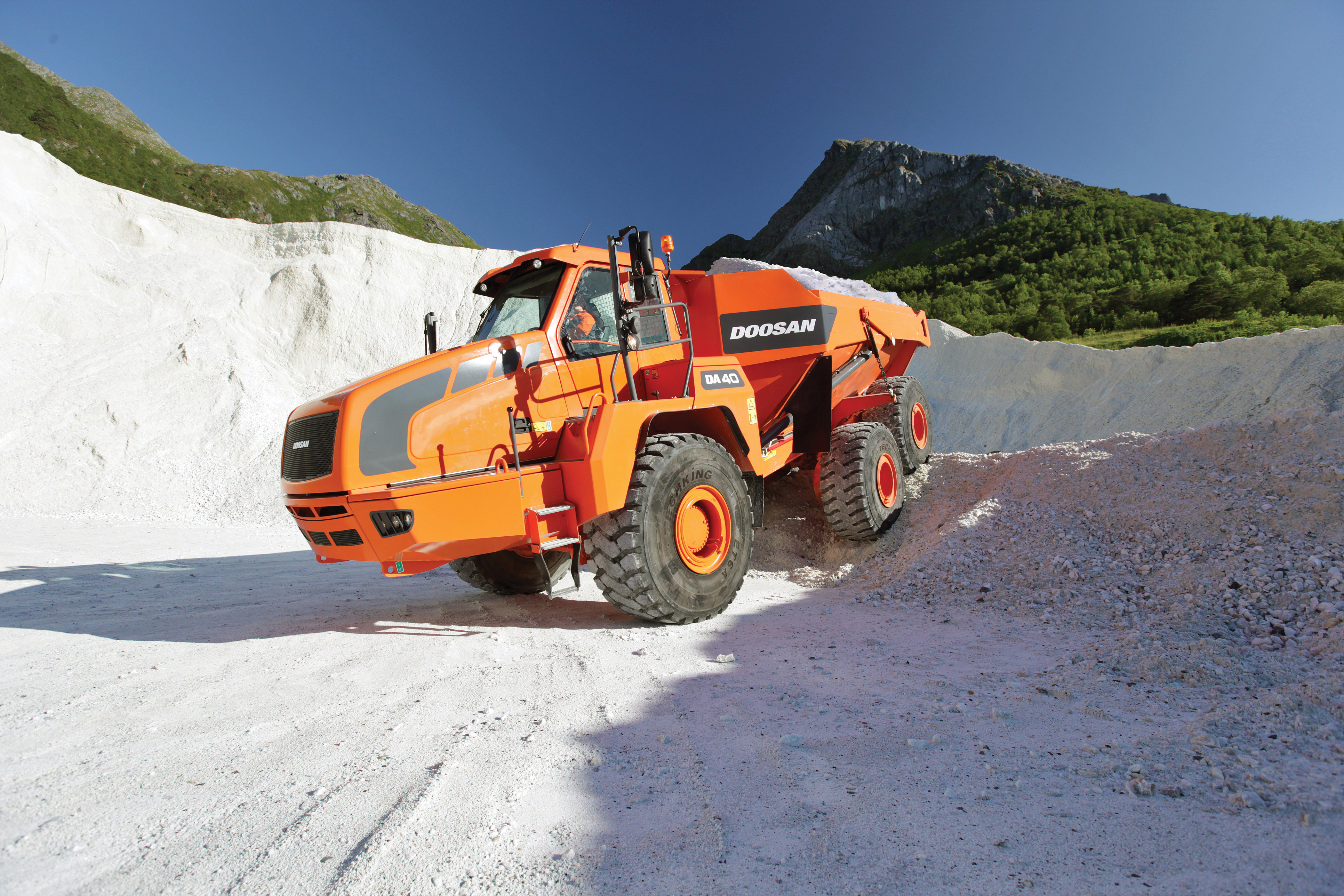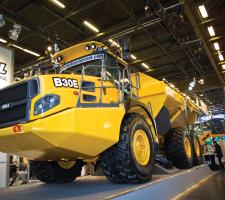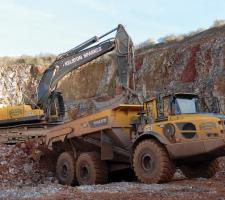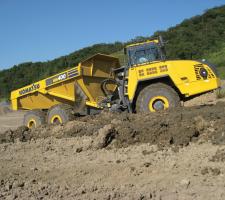
Specialist equipment is used in getting rock from the quarry face to the processing units as Patrick Smith reports
Hauling fragmented rock from the quarry face to the crushing, screening and washing set-up or dump site may seem a simple task but it has its complexities.
Quite apart from the sophisticated equipment used, it is also important the haul roads used are of the correct construction to maximise productivity and availability, bearing in mind the tough use to which vehicles subject them and to which vehicles are subjected.
The development of articulated dump trucks (ADTs) in recent years offers an alternative to rigid trucks, although both have their benefits, with an ADT able to handle steep ramp hauls and offer traction where there has been heavy rainfall or on sites with high clay content.
While ADTs also offer versatility, meaning they can easily be moved around from one job to another, rigid trucks are often kept at the same site for years.
Haul trucks, articulated and rigid, along with conveyors, perform the heavy lifting and moving in quarry operations.
Getting the right trucks and using them in the most productive manner is the key to improving an operator’s bottom line, says
“Proper payload management is not only important to the health of equipment, but to the health and safety of employees. That is why it is important to understand the 10/10/20 rule, and to follow it,” says the company.
According to Caterpillar the rule states that no more than 10% of payloads may exceed 1.1 times the truck’s target payload and no single payload shall ever exceed 1.2 times the maximum target payload or put another way no more than 10% of loads may exceed 10% over target payload and no loads may exceed 20% over target payload.
Last year it introduced its next generation of articulated trucks (ADTs), the new B Series models, which now include the 735B, offering a 32.7tonne payload; the 740B with its 39.5-tonne payload and the 740B EJ with the ejector body, carrying a 38-tonne payload. All three models are available with either Tier2/Stage2 equivalent or Tier 4 Interim/Stage IIIB certified emissions configurations to meet the needs of global customers.
Caterpillar has also introduced its new Cat 777G off-highway truck in the 91tonne size class.
Only recently, South African company
According to Bell, the E-series promises higher payloads across the range as well as improved safety features and better durability.
“In our design brief we addressed the ease of building the E-series so that we could look to increase our already high levels of quality into the way we manufacture. By further improving on our quality in the design and manufacture processes we have been able to build an even more reliable and durable truck,” says Bell’s head of engineering, Pieter Goosen.
According to Goosen, Bell has been developing the E-series for the past five years and is currently in the final stages of durability testing, having enlisted reputable independent national and international test facilities for additional verification.
He says that development has followed a well-structured process that has included customer interaction, concept vehicles and prototypes to ensure a strong, reliable product.
Extensive testing formed part of the process and engineers used structural analysis and dynamic analysis along with a rigorous testing programme on some of the harshest mine sites in the world to ensure that the E-series is worthy of taking the Bell marque forward.
“We believe that our D-series has successfully met the challenges of the world’s job sites and has many strengths and features across the range that our customers would like to see carried forward in our product advancement,” says chief executive Gary Bell.
“Therefore we have adopted an evolutionary approach to the E-series, to build on the legacy of the D-series generation and our decades of experience in design and manufacture, rather than a revolutionary clean-sheet design. We’ve stuck to our design principles of delivering weight-optimised, high-production trucks with superior tractive effort but looked at ways of doing things smarter.”
In Europe the E-series trucks will continue to use Bell’s Blu@dvantage system.
Earlier this year and marking the 40th anniversary since buying its first
The 40tonne trucks are deployed on a contract within one of the largest quarries in the Mendip Hills and join an existing mixed fleet of 12 of Sparkes’ A30Es and A40Es ADTs helping to resite some 4million tonnes of scalpings from the quarry’s old tip to a worked out area of the site which involves a 2.5km round trip in order to expose a fresh reserve or urgently required stone. Elsewhere in an adjacent part of the quarry Kelston Sparkes is engaged in loading and hauling blasted limestone from the face to the quarry’s mobile crusher which involves hauling 1.4 million tonnes of rock on a rolling five-year contract.
Volvo Construction Equipment has also celebrated after the A40F received the red dot: best of the best product from red dot product design awards 2012 in category 16 (automobiles, transportation, commercial and water vehicles) after being judged by a panel of design experts in Essen, Germany.
“The expert jury thoroughly examined, tested and evaluated each individual entry,” says Professor Dr. Peter Zec, the initiator and CEO of the red dot design award.
A letter of intent says that from 2014
“In the long term we are estimating delivery of well over 3,000 engines annually to Doosan Infracore. This cooperation has strengthened our position in the growing Asian market,” says Robert Sobocki, senior vice president and head of Scania Engines.
Doosan Infracore is well positioned within the Chinese market where several models from a total of more than 20,000 machines sold annually in China will be powered by Scania engines.
“We have tested Scania’s engines in our products and they meet our expectations for reliability, performance and high fuel efficiency,” says Andrew H Choi, sourcing director at Doosan Infracore.
Indeed, Doosan’s DA40, the first in a new range of ADTs, is powered by the six-cylinder Scania DC13 Tier 2 diesel engine with a gross power output of 368kW at 2,100rpm. The new ADT is said by the company to offer 10% more engine power than the previous MT41 model, which it replaces.
The South Korean company also says that the machine’s gross torque of 2,373Nm at 1,300rpm is a 22% increase on the MT41.
The DA40 has an increased body capacity of 24.4m³ and the payload has been boosted to 40tonnes without tailgate, an increase of more than 15% over the payload of the MT41.
“The higher speeds and payloads will allow the customer to increase profits from their mining, quarrying or earthmoving operations,” says Doosan.
“Through body design optimisation, the HM400-3 features increased body capacity and payload. The low 3,164mm loading height easily matches with 30-60tonne hydraulic excavators or 3.8m³-5.7m³ wheeled loaders. In addition, the two single-staged body lift cylinders provide a 70° dump angle for easy unloading,” says Komatsu.
“Thanks to Komatsu’s standard hydro-pneumatic suspension system on the front and rear axles, an optional payload system is available to optimise productivity and reduce repair costs caused by possible overload. This payload system offers on-the-spot data on the monitor panel, and is also transferred through KOMTRAX, Komatsu’s wireless monitoring system. A follow-up of the truck’s efficiency is quick and easy, with no loss of time.”
As with all ADTs, traction is vital, and the HM400-3 features the new Komatsu Traction Control System (K-TCS), which as with many ADTs, automatically provides optimum traction on any type of ground.
“As ground conditions worsen and tyre slippage is detected by speed sensors located on four wheels, automatic application of the inter-axle differential lock occurs. If tyre slippage continues to be detected then four independent brakes automatically apply to slipping wheels to regain traction and reduce tyre wear.

















